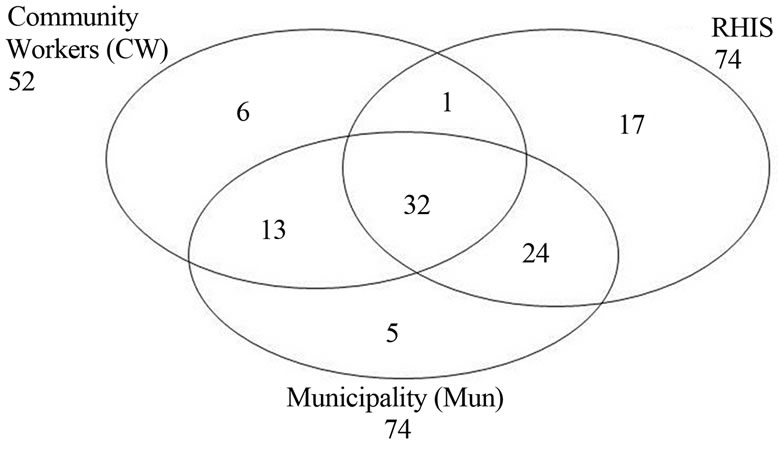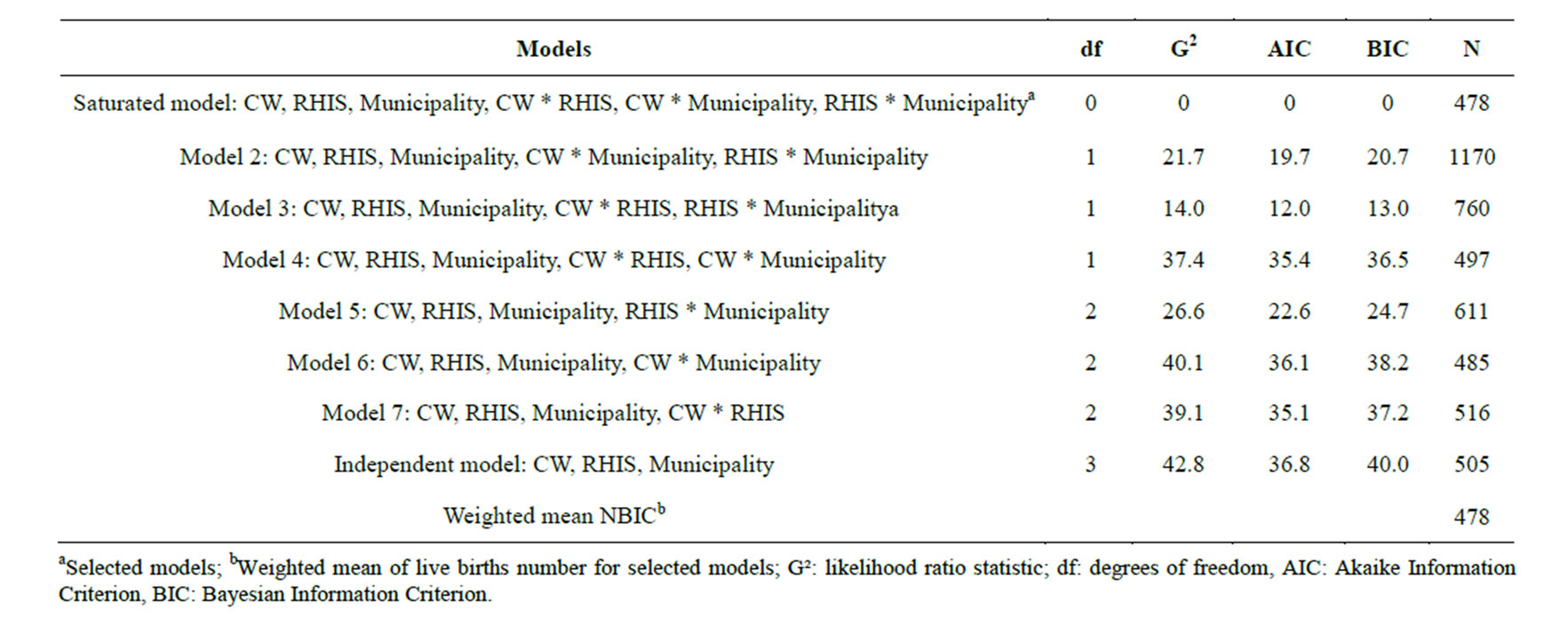Community workers contribution for data quality improvement in routine health information system: Live births number estimation by capture recapture method ()
While in developed countries HIS provide most of this information, the low performance of HIS in developing countries does not make it possible to obtain this vital data [1,5-8]. Although they are more or less operational in most developing countries, HIS are currently described as ineffective for several reasons, such as the insufficient exhaustiveness, quality and use of the data collected [9-12].
In Benin, the RHIS, known as the Système National d’Information et de Gestion Sanitaire (SNIGS), is based on data routinely collected from health facilities. It comprises several sub-systems, including the birth registration sub-system. Various internal and external evaluations of the SNIGS agree on the poor performance of this sub-system [9,13,14]. According to the World Health Statistics 2013, birth registration coverage in Benin from 2005 to 2011 was 60% [15].
To improve the exhaustiveness of information concerning vital events, various strategies have been proposed and implemented at national level in countries such as Ghana and India, with varying degrees of success [6,8,16]. On a more local level, in Malawi, Indonesia and DRC, studies have identified positive experiences with community-based organisations [4,17-19]. According to these studies, the workers of community-based organisations or community workers (CW) could represent an opportunity to improve the performance of RHIS as regards the exhaustiveness of vital events.
Community workers play a key role in health systems in developing countries. Many projects are implemented at community level thanks to these players whose integration within the health system and motivation remain unresolved [20,21]. In some health zones in Benin, there are a number of community worker networks more or less operational under community projects financed by technical and financial partners. This study aimed to assess the contribution of an existing operational community worker network to improving the performance of RHIS in reporting live births in rural Benin.
2. CONTEXT AND STUDY METHODS
2.1. Context
The study was conducted in the health zone of Ouidah in the south of Benin. The health zone covers an essentially rural population of approximately 300,000 inhabitants. The strategy of providing community care for malaria cases, with the support of technical and financial partners, has been in application in some of the villages in this health zone since 2008. This strategy mainly relies on community worker networks trained for the purposes of the project. These community workers therefore have close contact with this project’s target groups, which are children under five and their mothers in each village. Each village involved in community-based malaria care has at least one trained community worker. The community workers work under the supervision of the health worker responsible for the health centre that covers the village. They provide a monthly activity report which gives an overview of all activities concerning treatment, referrals and medicine transfers.
2.2. Methods
2.2.1. Type of Study
This study was an interventional one and analysed the exhaustiveness of the vital data registration system using the capture-recapture method [22-25].
2.2.2. Village Samples
Fourteen (14) villages were selected from within the health zone based on the effective level of operation of the CW network and its activities, along with the expected stability of the populations in these areas. Villages accommodating nomadic populations were excluded. The level of operation was assessed on the availability of activity reports over the last six months, and the final selection was made with the district medical officer and the health workers overseeing the project. The villages were divided into two groups for the collection of data. Group 1 comprised 8 villages and group 2 was made up of 6 villages. According to estimates made on the basis of the last population census, 170 live births were expected in group 1 and 77 live births were expected in group 2 for the period covered by the study; the rate of health service use for childbirth was 43.2% in group 1 and 80.3% in group 2 [26]. In group 1, the community workers collected information relating to live births in their village retrospectively and, in group 2, this data collection was a forecast.
2.2.3. Data Sources
In this study, three sources of data were used: the community workers through a community survey, the RHIS, and the municipalities through the district or municipal birth registry.
Community Survey: The community workers of each village were invited to produce a list of all the live births that they knew of and that had occurred in their village during the three months preceding the day of the survey. On the basis of this list, agreed and validated by the community worker or contacts and supplemented with information needed to identify the households concerned, a community survey was conducted among the households to confirm whether or not a live birth had actually taken place in the period under analysis and to collect the associated data. In the villages from group 1, the community workers were not warned in advance of the survey, so the information was collected by the community workers retrospectively, from their memory and from information from their local network. In the villages in group 2, a working session with the community workers was held four months before the survey. This session clarified the results expected from the community workers and emphasised the passive nature of the data collection carried out by them; they were to avoid seeking the information from other sources. Unlike the first group, the collection of information by the community workers in this second group of villages was a forecast. This approach in the second group aimed at improving the exhaustiveness and quality of the information provided by the community workers and at better ensuring that the community workers and the other sources of information were independent of one another.
Routine Health Information System (RHIS): The RHIS data collection tool, the birth records available at health centre level, provides all the information relating to deliveries and births in the public health centres and village health units, and in certain private centres participating in the RHIS.
District or Municipal Births Registry: The registry compiles all the information concerning births that have taken place within the geographical area of the municipality. All births must be registered within ten days. When the birth occurs in a public or legal private health facility, the parents are issued with a birth record so that they can register the birth with the municipality. When the birth takes place outside of a public or legal private health facility, the parents must go directly to the municipality to register the birth. The municipality is, in theory, the compulsory declaration source, but there is no penalty if the child is not declared and, at present, parents register births if they want to.
2.2.4. Survey Process
The data collection was carried out by three groups of interviewers trained separately and sent separately to the three sources of data to identify live births. The household survey and the data collection from the health centre RHIS were carried out at the same time while the data collection from the birth registries was carried out 15 days later.
2.2.5. Operational Definition of Live Birth
We used the WHO definition, cited by Statistics Netherlands Office, according to which a live birth is a birth with any other evidence of life [27].
2.2.6. Cross-Referencing Variables
The variables collected and used to cross-reference the data were: the date of birth, the child’s sex, the father’s name and surname, the mother’s name and surname, and the place of residence.
2.2.7. Data Analysis and Processing
The data was recorded in Excel 2007 and processed with Stata 13. The database was cleaned to remove duplicates. Multiple births were taken into account once the sources had been confirmed. We evaluated the dependency of the sources on each other with odds ratios (OR) and with their confidence interval at 95% (CI95%) [28,29]. We carried out log linear modelling. All possible combinations were tested ranging from the model with three independent sources to the saturated model with three sets of interaction between pairs of sources. The selection of plausible models was based on the lowest Akaike Information Criterion (AIC) and Draper’s Bayesian Information Criterion (BIC) values [30,31]. For all of the models, we estimated the number of births not reported by any of the three sources. From this, we deduced an estimate of the total number of births for each model and an average BIC-weighted estimate of the total number of births on the basis of the models selected [22,30,31]. A corrective adjustment was made (add 1) for cells with very low values [25,32].
2.2.8. Ethical Considerations
The research protocol for this project was approved by the Benin National ethics committee for research in health (Comité National d’Ethique pour la Recherche en Santé) and also by the regional authorities and the local health authorities. The community workers and the household respondents were given an information form and gave their informed consent before participating in the study.
3. RESULTS
In total, 391 live births were reported in group 1 and 98 in group 2 for the period covered by the study. These were distributed between the groups of villages as shown in Figures 1 and 2.
In group 1, half of the 81 births not identified by the municipality were reported by each of the other sources and there was a positive dependency between the sources taken in pairs. As such, ORRHIS-CW = 4.2; CI95%: [2.3 - 7.8], ORMunicipality-CW = 8.9; CI95%: [2.0 - 39.3], ORRHIS-Municipality = 31.3; CI95%: [6.8 - 143.2]. ORRHIS-CW was the lowest; the dependency between the CW source and the RHIS was less significant. In group 2, 24 births were not identified by the municipality and there was no de-

Figure 1. Distribution of live births according to the sources of information in group 1 villages.
pendency between the CW source and the RHIS source (ORRHIS-CW = 0.51; CI95%: [0.2 - 1.6]. There was a positive dependency between the other sources taken in pairs. As such, ORRHIS-Municipality = 7.4; CI95%: [1.6 - 135.0],

Figure 2. Distribution of live births according to the sources of information in group 2 villages.
ORMunicipality-CW = 11.3; IC95%: [2.8 - 182.4].
On the basis of the estimated number of births not reported by any of the sources, in group 1, the average weighted estimate of the total number of live births was 478 and the exhaustiveness of the various sources was 64.8% for the municipality, 29.3% for the RHIS and 20.1% for the CWs. The number of births not reported by any of the sources amounted to 18.2% and the number of births not registered (in the RHIS or by the municipality) amounted to 26.8% (Table 1). In group 2, these same estimates make it possible to surmise that the total number of live births was 120 and the exhaustiveness of the various sources was 61.7% for the municipality, and for the RHIS and 43.3% for the CWs. The number of births not reported by any of the sources amounted to 18.3% and the number of births not identified by the RHIS or the municipality amounted to 23.3% (Table 2).

Table 1. Estimation of live births number (N) and weighted mean of live births number (NBIC) in group 1.

Table 2. Estimation of live births number (N) and weighted mean of live births number (NBIC) in group 2.